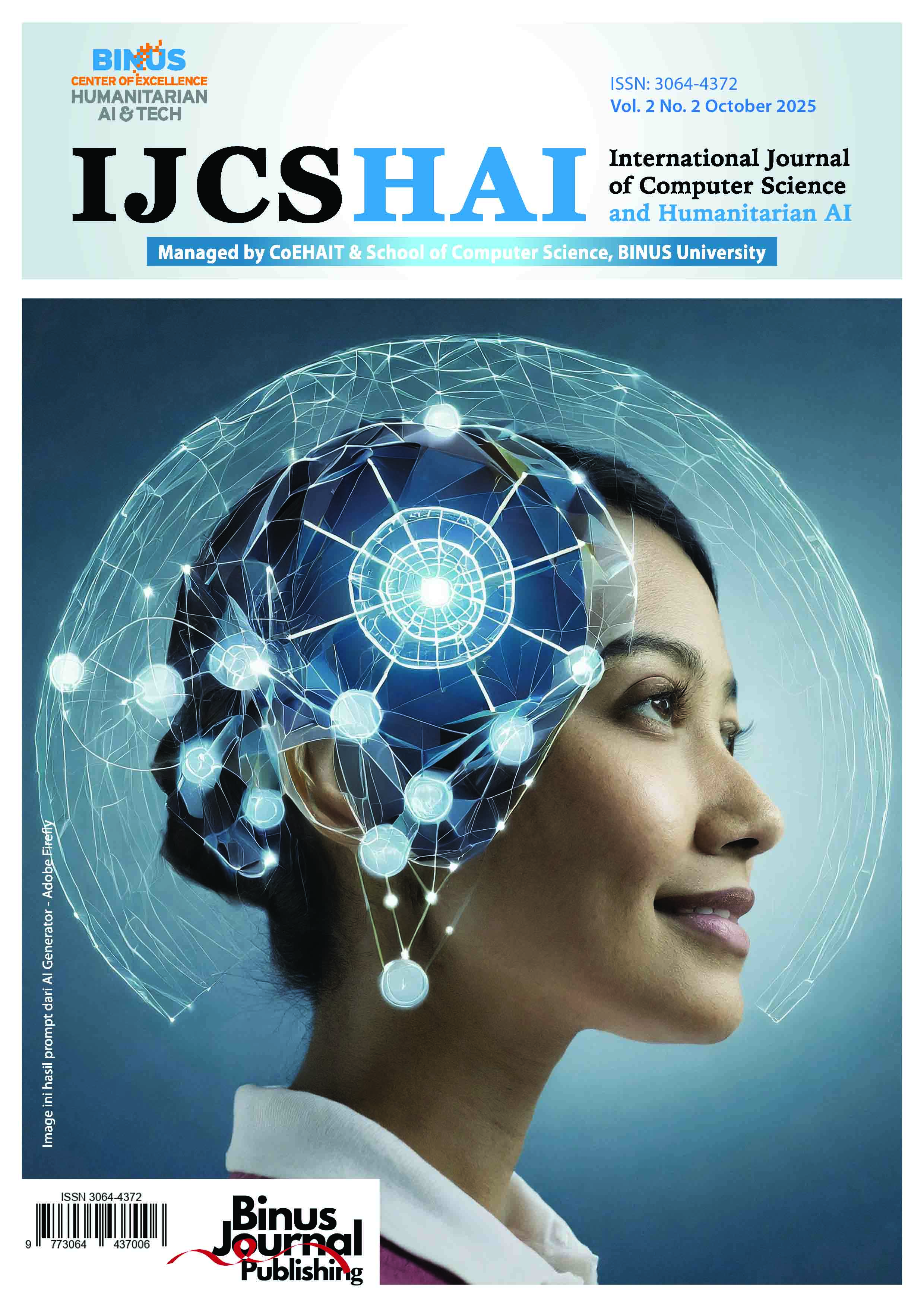Design and Implementation of Chatbot Pancasila for Teaching Pancasila and Character Building for University’s Students
DOI:
https://doi.org/10.21512/ijcshai.v2i2.14418Keywords:
Pancasila, Character Building, Chatbot, AI, NLPAbstract
In the modern era, where global influences are rapidly shaping young minds, the need to maintain strong national identity and moral values is more crucial than ever. For Indonesian students, Pancasila education and character building play a central role in developing not only academic competence but also personal integrity and social responsibility. The design approach involved analyzing student needs, integrating Pancasila-based content, as well as applying automated learning algorithms so that the chatbot can provide answers that match the context of the conversation especially Character-Building Pancasila topics. This Pancasila Character Building Chatbot is designed with Natural Language Processing (NLP) technology to provide creative, interactive, and interesting learning experiences that are easily understood by students. Implementation is done through a digital platform that allows students to interact in real-time in understanding the values of Pancasila, such as divinity, humanity, unity, democracy, and social justice. Furthermore, this innovation aims to bridge the gap between traditional moral education and modern digital learning methods. By utilizing artificial intelligence, the chatbot can adapt to different learning styles and provide personalized feedback to each student. It is hoped that the presence of Chatbot Character Building Pancasila can increase the enthusiasm for learning and curiosity of students so that learning character building Pancasila is more creative and interesting for students in university classrooms.
References
[1] R. Ramadhani, “Characteristics of Generation Z in the Digital Era,” Jurnal Ilmu Manajemen dan Kewirausahaan (JIMKES), vol. 5, no. 2, pp. 115–126, 2024. [Online]. Available: https://jurnal.ibik.ac.id/index.php/jimkes/article/download/2904/2190
[2] F. Nuraini and D. Putri, “Social Media Behavior and Ethical Challenges of Generation Z in Indonesia,” International Journal of Humanities and Social Science (IJHSS), vol. 8, no. 1, pp. 34–45, 2023. [Online]. Available: https://ejournal.uit-lirboyo.ac.id/index.php/IJHSS/article/view/5966
[3] K. P. Siregar and N. F. Ardiyanto, “The Impact of Social Media Dependence on Generation Z’s Psychological Well-Being,” Jurnal Komunikasi Ikatan Sarjana Komunikasi Indonesia (JKISKI), vol. 9, no. 2, pp. 201–214, 2024. [Online]. Available: https://www.jurnal-iski.or.id/index.php/jkiski/article/download/958/pdf
[4] “Pancasila,” Encyclopaedia Britannica, 2024. [Online]. Available: https://www.britannica.com/topic/Pancasila
[5] A. H. Yuliana, “The Universal Values of Pancasila in Modern Indonesia,” Awang Long Law Journal, vol. 5, no. 2, pp. 45–52, 2023. [Online]. Available: https://www.ejournal.stih-awanglong.ac.id/index.php/awl/article/view/1034
[6] Jihan Fadhillah and Usiono, “The Role of Pancasila in the Advancement of Science and Technology”, Jurnal Pendidikan Bhineka Tunggal Ika, Vol. 2, no. 1, pp. 155-161, 2024.
[7] Bahari Ikrom et.al, “Utilization of Technology for the Implementation of Pancasila Education in Strengthening Values in the Digital Era”, Jurnal Inovasi Ilmu Pendidikan Vol.2, No.3, pp. 209-215, 2024
[8] Frederikus Fios (2020) “The Praxis of Sustainability Development in the Ideology of Pancasila: Ecological Insights from Indonesia” in International Journal of Innovation, Creativity and Change. www.ijicc.net Volume 14, Issue 3, pp. 173-184.
[9] Nurdin et.al (2025) “Screening Mobile Aplication Based on Social Ecological Model with Pancasila in Learning as an effort to prevent radicalism in the digital era” in Journal of Engineering Science and Technology, 20(3), pp. 97–104.
[10] J. A. Rodríguez and M. S. Alonso, “Chatbots in Education: A Systematic Review,” Smart Learning Environments, vol. 11, no. 1, 2023. [Online]. Available: https://educationaltechnologyjournal.springeropen.com/articles/10.1186/s41239-023-00426-1
[11] D. Jurafsky and J. H. Martin, “Speech and Language Processing,” Stanford.edu, 2018. https://web.stanford.edu/~jurafsky/slp3/
[12] T. Wolf et al., “Transformers: State-of-the-Art Natural Language Processing,” Proceedings of the 2020 Conference on Empirical Methods in Natural Language Processing: System Demonstrations, pp. 38–45, 2020, doi: https://doi.org/10.18653/v1/2020.emnlp-demos.6.
[13] C.-C. Lin, A. Y. Q. Huang, and S. J. H. Yang, “A Review of AI-Driven Conversational Chatbots Implementation Methodologies and Challenges (1999–2022),” Sustainability, vol. 15, no. 5, p. 4012, Feb. 2023, doi: https://doi.org/10.3390/su15054012.
[14] R. Winkler and M. Soellner, “Unleashing the Potential of Chatbots in Education: A State-Of-The-Art Analysis,” Academy of Management Proceedings, vol. 2018, no. 1, p. 15903, Aug. 2018, doi: https://doi.org/10.5465/ambpp.2018.15903abstract.
[15] P. Lewis et al., “Retrieval-Augmented Generation for Knowledge-Intensive NLP Tasks,” arXiv.org, Apr. 12, 2021. https://arxiv.org/abs/2005.11401
[16] H. Lu et al., “DeepSeek-VL: Towards Real-World Vision-Language Understanding,” arXiv.org, 2024. https://arxiv.org/abs/2403.05525
Downloads
Published
How to Cite
Issue
Section
License
Copyright (c) 2025 Karina Dwinovera Mulia, Widodo Budiharto, Heri Ngarianto, Frederikus Fios

This work is licensed under a Creative Commons Attribution-ShareAlike 4.0 International License.
Authors who publish with this journal agree to the following terms:
- Authors retain copyright and grant the journal right of first publication with the work simultaneously licensed under a Creative Commons Attribution License - Share Alike that allows others to share the work with an acknowledgment of the work's authorship and initial publication in this journal.
- Authors are able to enter into separate, additional contractual arrangements for the non-exclusive distribution of the journal's published version of the work (e.g., post it to an institutional repository or publish it in a book), with an acknowledgment of its initial publication in this journal.
- Authors are permitted and encouraged to post their work online (e.g., in institutional repositories or on their website) prior to and during the submission process, as it can lead to productive exchanges, as well as earlier and greater citation of published work.
USER RIGHTS
All articles published Open Access will be immediately and permanently free for everyone to read and download. We are continuously working with our author communities to select the best choice of license options, currently being defined for this journal as follows: Creative Commons Attribution-Share Alike (CC BY-SA)





